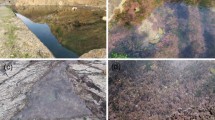Abstract
Regular surveys of heterotrophic microflora from seawater were conducted in the subantarctic (Kerguelen archipelago) and Antarctic (Terre Adélie area). Although a predominance of psychrophilic bacteria could be expected for such polar marine environments, there were no significant differences between results obtained after incubation at two different temperatures (4°C for 21 days or 18°C for 6 days). To investigate this further, four sets of bacterial strains were isolated from the subantarctic area (early fall, late fall, spring, and summer) and one set of Antarctic bacteria was isolated in summer. The growth rates of the 143 strains collected were determined at four different temperatures (4, 7, 20, and 30°C). The results clearly indicated that a large majority of the isolated bacteria must be considered psychrotrophic and not truly psychrophilic strains.
Similar content being viewed by others
References
Baleux B (1977) A computer study of the evolution of aerobic bacterial populations in sewage and river waters. Microb Ecol 4:53–65
Baross JA, Morita RY (1978) Microbial life at low temperatures: Ecological aspects. In: Kushner DJ (ed) Microbial life in extreme environments. Academic Press, London, New York, San Francisco, pp 9–71
Bhakoo M, Herbert RA (1980) Fatty acid and phospholipid composition of five psychrotrophicPseudomonas spp. grown at different temperatures. Arch Microbiol 126:51–55
Bouvy M, Delille D (1987) Numerical taxonomy of bacterial communities associated with a subantarctic mussel bed. Helgolander Meeresuntersuchungen 41:415–424
Bouvy M, Delille D (1988) Spatial and temporal variations of Antarctic and SubAntarctic bacterioplankton. Neth J Sea Res 22:139–147
Boyd WL, Staley JT, Boyd JW (1966) Ecology of soil microorganisms of Antarctica. In: Tedrow JCF (ed) Antarctic soils and soil-forming processes. Antarctic Res Ser 8:125–159
Christian RR, Wiebe WJ (1974) The effects of temperature upon the reproduction and respiration of a marine obligate psychrophile. Can J Microbiol 20:1341–1345
Delille D (1987) Spatial distribution of coastal Antarctic seawater bacteria: Relationship with avifauna. Polar Biol 8:55–60
Delille D, Bouvy M, Cahet G (1988) Short-term variations of bacterioplankton in Antarctic zone: Terre Adélie area. Microb Ecol 15:293–309
Delille D, Imbaud P (1988) Seasonal changes of heterotrophic bacteria in subAntarctic sea-water. Fifth symposium on Antarctic Biology. Hobart 1988
Delille D, Lemoine G (1987) Dynamique saisonnière des microflores hétérotrophes marines subantarctiques. CNFRA 57:27–36
Eddy BP (1960) The use and meaning of the term “psychrophilic.” J Appl Bacteriol 34:189–190
Gillespie PA, Morita RY, Jones LP (1976) The heterotrophic activity for amino-acids, glucose and acetate in Antarctic waters. J Oceanog Soc Jap 32:74–82
Herbert RA, Tanner AC (1977) The isolation and characterisation of photosynthetic bacteria (Chromatiacaea andChlorobiacaea) from Antarctic marine sediments. J Appl Bacteriol 43:437–446
Inoué K, Komagata K (1976) Taxonomic study on obligately psychrophilic bacteria isolated from Antarctica. J Gen Appl Microbiol 22:165–178
Kottmeier ST, Sullivan CW (1988) Sea ice microbial communities 9. Effects of temperature and salinity on rates of metabolism and growths of autotrophs and heterotrophs. Polar Biol 8:293–304
Madden JM, Siegel SK, Johnson RM (1979) Taxonomy of some AntarcticBacillus andCorynebacterium species. Terrestrial biology III. Parker B (ed). Antarctic Res Ser 30:77–103
McMeekin TA, Franzmann PD (1988) Effect of temperature on the growth rates of halotolerant and halophilic bacteria isolated from Antarctic saline lakes. Polar Biol 8:281–285
Morita RY (1975) Psychrophilic bacteria. Bacteriol Revs 39:144–167
Norkrans B, Stehn BO (1978) Sediment bacteria in the deep Norwegian Sea. Mar Biol 47:201–209
Oppenheimer CH, Zobell CE (1952) The growth and viability of sixty-three species of marine bacteria as influenced by hydrostatic pressure. J Mar Res 11:10–18
Reichardt W (1988) Impact of the Antarctic benthic fauna on the enrichment of biopolymer degrading psychrophilic bacteria. Microb Ecol 15:311–321
Simidu U, Kogure K, Fukami K, Imada C (1986) Heterotrophic bacterial flora of the Antarctic Ocean. Mem Natl Inst Polar Res Spec Issue 40:405–412
Straka RD, Stokes JL (1960) Psychrophilic bacteria from Antarctica. J Bacteriol 80:622–625
Wiebe WJ, Hendricks CW (1971) Simple, reliable cold tray for the recovery and examination of thermosensitive organisms. Appl Microbiol 22:734–735
Wiebe WJ, Hendricks CW (1974) Distribution of heterotrophic bacteria in a transect of the Antarctic Ocean. In: Colwell RR, Morita RY (eds) Effect of environment on microbial activities. University Park Press, Baltimore, pp 524–535
Author information
Authors and Affiliations
Rights and permissions
About this article
Cite this article
Delille, D., Perret, E. Influence of temperature on the growth potential of Southern polar marine bacteria. Microb Ecol 18, 117–123 (1989). https://doi.org/10.1007/BF02030120
Issue Date:
DOI: https://doi.org/10.1007/BF02030120




